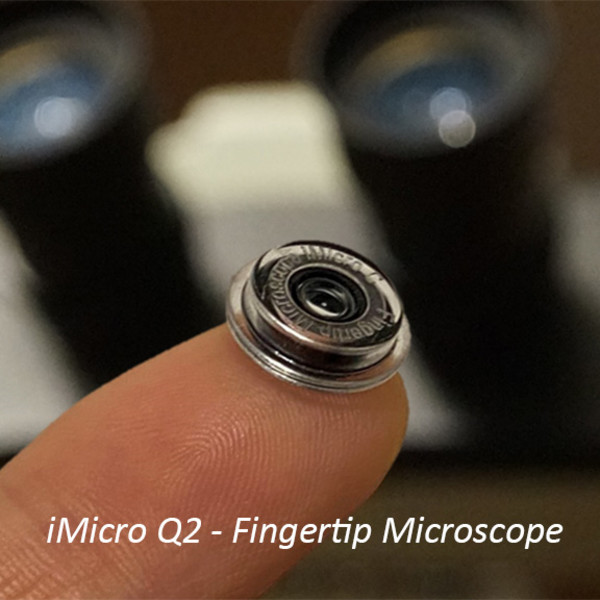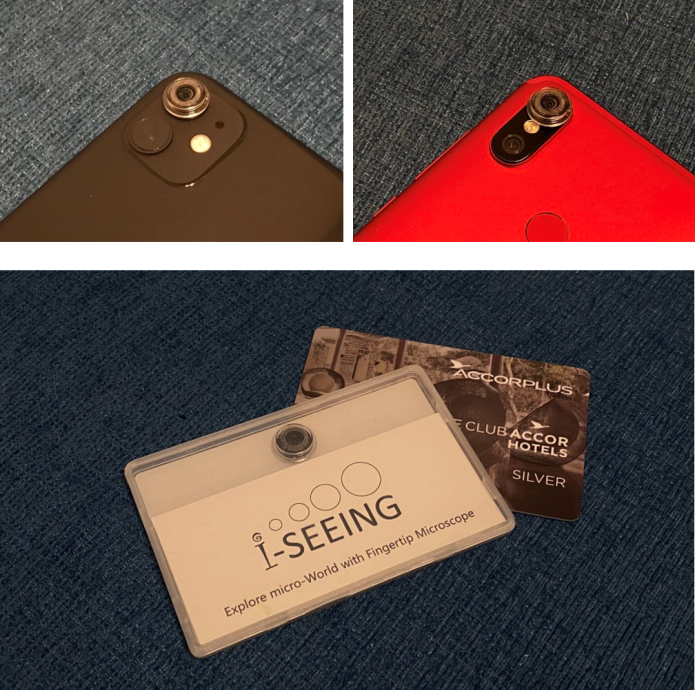
Get the optical performance of a professional desktop microscope with any typical smartphone!
In 2018, we took Kickstarter and Indiegogo by storm with the first Fingertip Microscope – iMicro Q, earning 6000 pledges from the community and over 10000 iMicro Q delivered to our backers. Since then, we’ve launched another iMicro C in 2019, with a longer working distance and a broader field of view. We delivered over 14000 Fingertip Microscopes units with these two successful, accomplished campaigns to microscope fans in over 70 countries. It is a breakthrough in portable microscopy – we’re quite proud, and thank you all for your support.

We never stop – now we’ve taken our effort one step further and are pleased to bring you the new, improved version of fingertip microscope – iMicro Q2.
What is Fingertip Microscope (iMicro Q2)?
Since Antony van Leeuwenhoek invented his microscope in the 17th century, there has been tremendous progress in microscope technology. Microscopes with excellent performance are usually bulky, heavy, and expensive, even for portable ones. With our years of effort, what we introduced in 2018 – the fingertip microscope iMicro Q – is a real breakthrough in mobile microscopy. It has the comparable optical performance to a professional desktop microscope and enables you to carry it with you as easily as you bring your phone. In addition to the iMicro Q’s excellent optical performance and portability, iMicro Q2 has a new design to enable it to work with any smartphone.

Highlights
- Very high magnification power: up to 800x
- Very low distortion: comparable to a desktop microscope
- Very high resolution power: down to 1 micron
- Extremely easy to use: “Stick and Play” with your phone
- Extremely low profile and weight: ½ inch and ~1/60 oz
- Extremely easy to carry: fit in wallet like a card
- Extremely low cost: ~1% of the price of a desktop microscope
- Compatible with any smartphone
Here are some micrographs took with iMicro Q2 (using an iPhone 11):

Key features of iMicro Q2
- Extremely high magnification: up to 800x
It has the same high magnification as iMicro Q. When used with a smartphone, it can observe, for example, at full view the mouth part of the housefly at a magnification of ~100x, and then zoom in detail up to 800x magnification. It is able clearly to see the spiral structure of the tip of the mouthpart at high magnification. If you don’t have a microscope, you never know a housefly has such a fine structure at its mouth part. It is amazing!

- Very high resolution
The clear observation of the spiral structure of the mouth part of the housefly is already proof of its high resolution. We did some further tests: the USAF 1951 resolution test chart was used to test the resolution of iMicro Q2 on an iPhone 11. The intervals between the finest test bars are 2.19 micrometers. The finest test bars on the 7th group are clearly seen, indicating its resolution is far beyond that.

- Very low distortion
A grid calibration target was used to test the distortion. Even in full view at the edge of the visual field, no noticeable distortion was observed.

Based on this optical performance test, iMicro Q2 has excellent optical performance, definitely comparable to a desktop compound microscope.
A stem of xylophytadicotylendon T.S. was observed under iMicro Q2 as well as a desktop microscope Motic DMB-1223 (price ~2200USD for microscope + 500USD for camera attachment). No noticeable difference was observed, as shown in a side-by-side comparison.

- Extremely low profile
It is about the size of a fingertip and weighs only 0.5g (~1/60 oz). It is very thin, only 3.2mm (1/8 inch). No parts extrude beyond the edge of your phone when it is installed. Also, We considered the portability of the package from the beginning of the design. It is packed in a card size thin PP case which is easy to fit into your wallet!

- Extremely easy to use
The Fingertip microscope is different from a comprehensive desktop microscope – it does not introduce a bulky and expensive focus tuning system. In contrast, the iMicro Q2 has no knobs and buttons at all. Compared with the original iMicro Q, the new iMicro Q2 is more comfortable to align and attach to your phone’s camera. Just connect and point closely towards what you want to see, and it works!
- Affordable to every budget
We are very proud of the Fingertip Microscope and would like everyone to be able to afford it. Even though it has such an excellent performance, we tagged with an attractive price: ~1 percent of a traditional desktop microscope cost. With the money you would need to buy a traditional desktop microscope, you will be able to purchase many Fingertip Microscopes, making this great for children and students.

- Works with any smartphone
When we launched iMicro Q, we were often asked: does this work with my phone? There is no more confusion with iMicro Q2: We design it to work with any phone with a camera. iMicro Q2 will be coupled to your smartphone by an innovative, re-useable, nano-suction pad. Whether your phone has a single back camera or multiple back cameras, a flat camera(s), or extruded camera(s), the iMicro Q2 will work with them all. Please see the picture for your reference to see how it looks with different camera configurations.

Principle and development process
- How it works
The magnification mainly relies on its complex optical system for traditional compound microscopes, including objective and eyepiece. Its total magnification is a combination of the magnification of objective and eyepiece.
For our fingertip microscope, three stages of magnification are combined to achieve the total magnification. First, the lens provides optical magnification to generate the image on the smartphone camera’s sensor; second, the image on the sensor is displayed on the much larger screen via the electronic process and magnification; third, digital zoom provides further magnification as a digital magnification to the image. The total magnification is a combination of these three.

Therefore, iMicro Q2 uses a different process and technology compared to a traditional microscope. Thanks to the advance of micro-optics and smartphone technology, and with the effort and expertise accumulated in the past years, we have enabled iMicro Q2 to achieve excellent performance at a low cost.
- Development path and process
We walked a long way to develop these smartphone-based microscopic tools since registering the first patent in 2012. We have already successfully built a series of smartphone microscope products, including iMICROSCOPE, iMICROSCOPE R, and the μRuler, iMicro Q, iMicro C as well as this new version iMicro Q2.

We have shaped and polished our Fingertip Microscope idea according to previous backers’ and customers’ suggestions and comments based on our previous successful projects. We have optimized the optics and the overall design, and each step was tested and refined using prototypes to achieve the best performance possible.

The essential techniques to achieve its high performance
- Dedicated optics: multi-element aspherical micro-lens
The lens is a crucial component of the system. A small ball lens (van Leeuwenhoek) is a straightforward approach. But it is well known to suffer from a very limited usable field of view due to severe field curvature effects, spherical and other aberrations. The iMicro Q2 uses a more complex multi-aspherical lens with a dedicated design to achieve both the high performance of magnification and low aberration.

- Innovative illumination: Reflection/transmission light design
Light and illumination are essential to microscopy. Nowadays, every smartphone comes with a camera as well as a flashlight. The original iMicro Q used a light guide technique to introduce the light to the point of the lens field of view. iMicro Q is a great design but incurs a compatibility problem with some of the phones with a long distance between the camera lens and flash.
In iMicro Q2, we incorporated a new innovative design: Reflective/Transmission illumination. In this design, the thin PP case is not only used to pack and protect the product but also used as a light-reflective illumination box. The light from the flashlight and ambient light go into the transparent light guide to illuminate the sample. Simultaneously, the light is also reflected from the thin PP case’s bottom wall to illuminate the sample. Because of this design, the Reflection/Transmission illumination achieves its high performance with flexibility to work with all the different phone camera lens – flash configurations and therefore being compatible with any smartphone. Even for the phones/pads which do not have a flashlight, it works well with just good ambient light illumination or using close to an ambient light source.

- Seamless coupling with the smartphone: Nano-suction pad attachment
Compared to conventional adhesive, the nano suction pad mimics gecko’s foot-pads: it has thousands of micro air pockets functioning like micro-suction cups to hold the device to the phone.

Every on and off application will leave nothing on the phone. This newly developed “nano suction pad” is residue-free, non-tacky, and repeatable. The use of a nano-suction pad has been proved in our previous product, and it is repeatable and easily cleaned by a PSA tape (such as Scotch tape).
- Precise focus control: automatic + manual focus
Every smartphone now has an auto-focus function. When iMicro Q2 is coupled with your smartphone, this automatic focus function also works. We have precisely designed and machined iMicro Q2 to control the focus point accurately. As long as you point it closely towards a sample plane, the sample falls into the autofocus range, and it will automatically focus for a clear image.
- μRuler and Dedicated App: for professional needs
A high-quality μRuler (stage micrometer) will be provided (as an option) with iMicro Q2 to calibrate the scale-bar in our App, i-Seeing, and enable you to measure size accurately. Please see our previous campaign, μRuler– A micro-ruler to measure micro-objects, for more information.

iMicro Q2 actually works with any camera App which can control the flashlight when shooting. In some cases, it is crucial to have a scale-bar and ensure its accuracy on the micrograph. The dedicated App, i-Seeing, was designed to take micrographs to meet professional demand. The scale-bar on the micrograph can be toggled on/off to enable you to embed a scale-bar on the image if required.

How to use it?
The iMicro Q2 is very easy to align and attach to the phone’s camera. Just connect and point closely towards what you want to see, and it works!
Critical improvements compared with iMicro Q
The iMicro Q2 is very easy to align and attach to the phone’s camera. Just connect and point closely towards what you want to see, and it works!
- Better optical performance – Although the lens optical technology is the same as with iMicro Q, we optimized the design of Q2 regarding structure and production stability. These improvements ensure the best performance and excellence in lens optics.
- Smaller and lighter – it is smaller and lighter and, more importantly, it has a round shape with optimized size, which enables it to stay firmly and stably attached to the camera lens.
- Easier to use – Thanks to its thin and round shape, it is easier to align with and attach to the camera lens.
- Works with any camera phone – The essential improvement is that it should work with any camera phone with dramatic evolution in compatibility with this new design.
Comparison between iMicro Q2 and iMicro C
The picture shows the comparison of the same scale target being observed with iMicro C and iMicro Q2 (when no digital zoom is applied), so you can compare their visual field. You will see they are complementary: iMicro C has a lower magnification and a larger visual field, while iMicro Q2 has a higher magnification and a high resolution. The detailed comparison between iMicro Q2 and iMicro C is shown in the table. They are both suitable for different yet complementary purposes.


What people say about Fingertip Microscope

Featured on media

Application examples
It is super portable, and you don’t need complicated settings, so you can immediately take images, use it for reporting, and transfer images to your colleagues. Plus, you can use it with any smartphone. It can be used in many professions where you need accurate changes and immediate research in the field. For example, it can monitor a knife’s sharpening process, check the masks’ quality, and measure small machinery parts’ quality. It can also check the mounting of samples on a TEM grid, check the quality and texture of cloth, identify the counterfeit, evaluate the printing quality, and check the flaws in jewelry and many other applications. It is not just a tool and can also be used for a lot of fun: parents might use it during play to explore the wonderful micro-world with their child.
Many of our previous backers shared their beautiful and amazing pictures when they used the fingertip microscopes. Here are a few examples of previous backers’ photos with the iMicro Q and iMicro C on their phones.

Highlights

Rewards

Timeline


